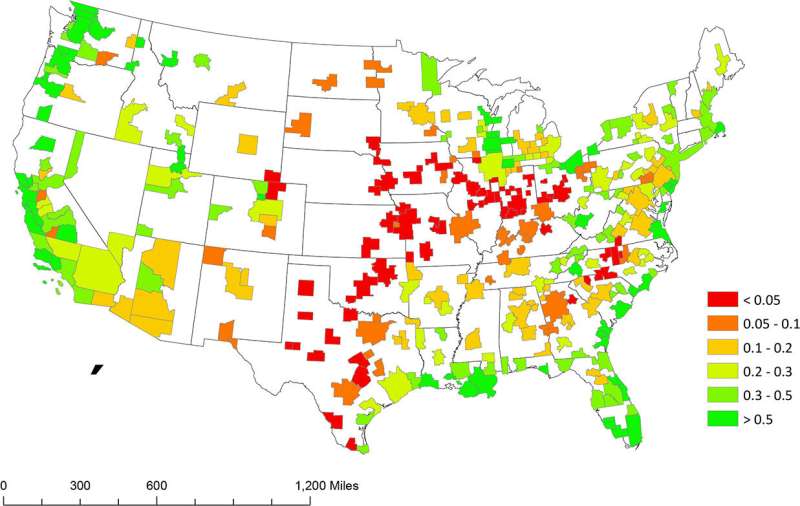This article has been reviewed according to Science X's editorial process and policies. Editors have highlighted the following attributes while ensuring the content's credibility:
fact-checked
trusted source
proofread
How much open space does an urban area need?

Around 97% of all metropolitan areas in the United States have insufficient open space, according to a new study published in the Journal of the Association of Environmental and Resource Economists. In the paper "Open Space in U.S. Urban Areas: Where Might There Be Too Much or Too Little of a Good Thing?" authors JunJie Wu, Jialing Yu, and Walid Oueslati analyze cities across the U.S. and develop a framework to assess if the amount of open space in an area is socially optimal.
The benefits of preserved open spaces like public parks are numerous and well recognized, especially in urban areas with dense populations. Open spaces provide opportunities to explore and experience nature, socialize, and participate in health-boosting recreational activities. The authors note that these boons were highlighted throughout the COVID-19 pandemic, when many people relocated away from dense urban centers to smaller towns or rural areas.
But open space is costly, both in terms of preservation costs and the fact that the real estate occupied by parks or other open spaces could be otherwise developed for housing, particularly in cities where affordable housing is scarce. Yet despite these costs, the benefits of open space prompted jurisdictions in the U.S. to set aside a total of $76 billion for land conservation between 1988 and 2017.
To find out if there is excessive or insufficient open space in U.S. cities, Wu, Yu, and Oueslati created a model that characterizes the optimal amount of open space in an urban area.
From satellite data, they quantified and estimated the amount of open space in a metropolitan area that could potentially be developed in the future (like farmland), the amount of natural open space that is unsuitable for development, and the amount of open space that is already preserved and cannot be developed. They combined these data with an analysis of housing supply and demand.
The authors find that the optimal amount of preserved open space in a city is determined by several factors: the price elasticities of local housing supply and demand, the economies of scale in municipal services provision, the benefits gained from open-space conservation (like higher property values or increased wildlife habitat), and the land constraints and scarcity imposed by an area's natural geography (for example, steep slopes or wetlands that cannot be developed).
Different types of open space have different impacts on housing demand in a city. Preserved open spaces like gardens and parks increase housing demand, for instance, while agricultural land has no or even a negative effect on housing demand.
When they apply their analysis to existing U.S. metropolitan areas, the authors find that the vast majority—97%—do not have enough open space, and that adding open space would increase land values and social well-being. In particular, the California metropolitan areas of San Francisco—Oakland—Fremont, Santa Cruz—Watsonville, and Sacramento—Arden-Arcade—Roseville, as well as Orlando, Florida, would benefit the most from preserving more open space in developed areas, they write.
Wu, Yu, and Oueslati offer several possible explanations as to why most urban areas in the U.S. have insufficient preserved open space. Their analysis reveals that much of the existing open space is provided by private developers or landowners, who might not have the incentive to provide more. Another reason could be limits on property tax increases, like California's Proposition 13, which curbs the effect of land value changes on property tax revenue. Public funds are stretched thin, and other competing demands often win out.
Ultimately, the authors write, "Open space is often regarded as a luxury rather than a necessary public service."
More information: JunJie Wu et al, Open Space in US Urban Areas: Where Might There Be Too Much or Too Little of a Good Thing?, Journal of the Association of Environmental and Resource Economists (2022). DOI: 10.1086/721756
Provided by University of Chicago



















